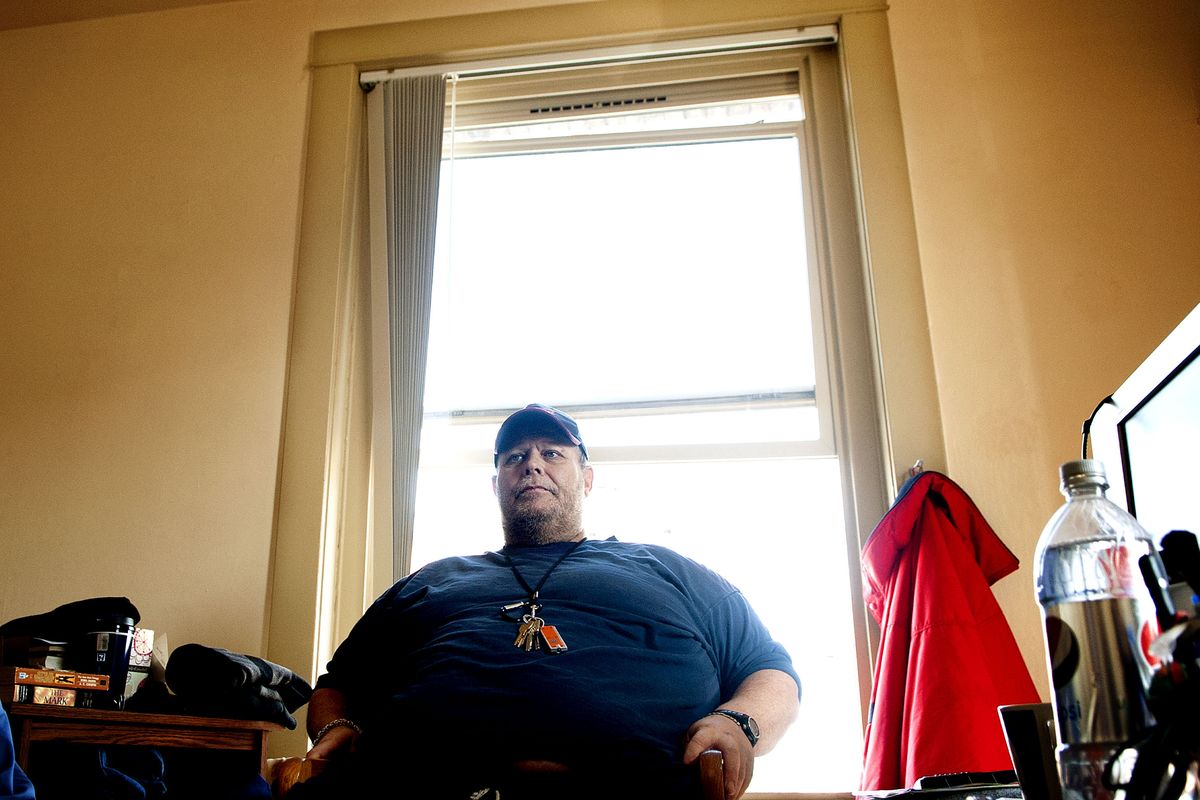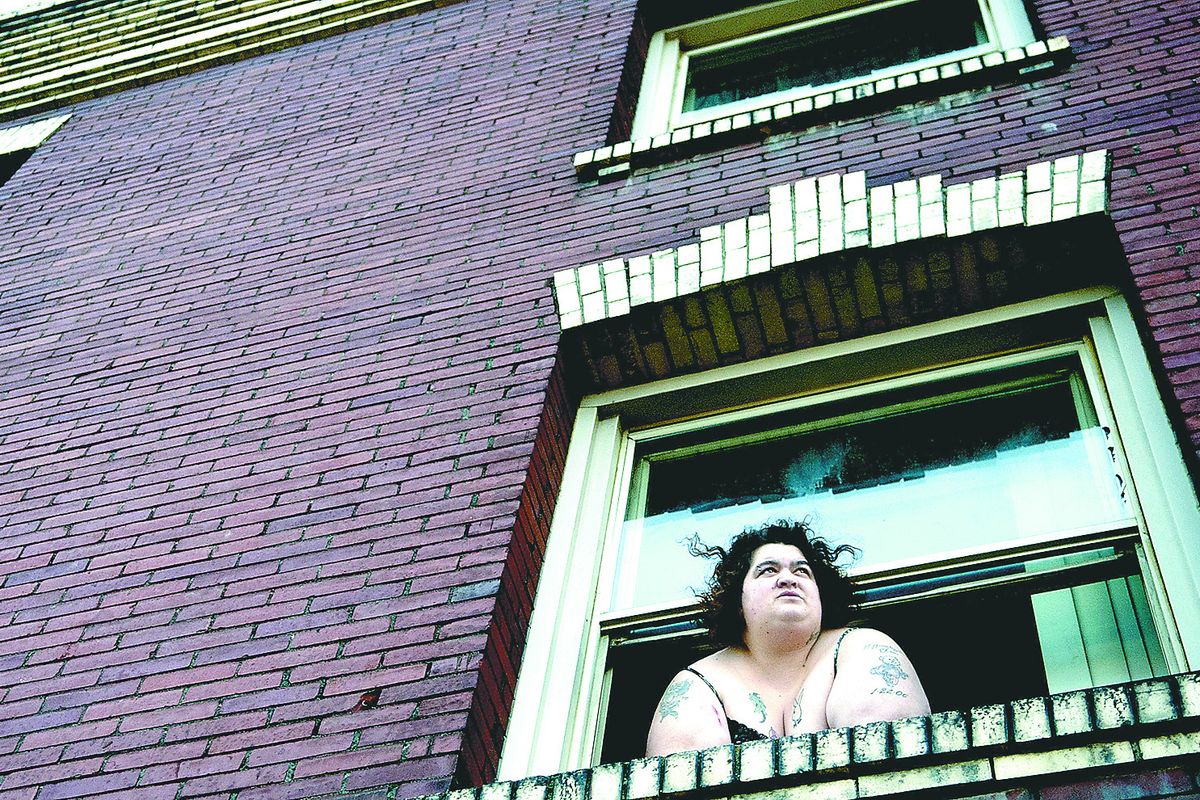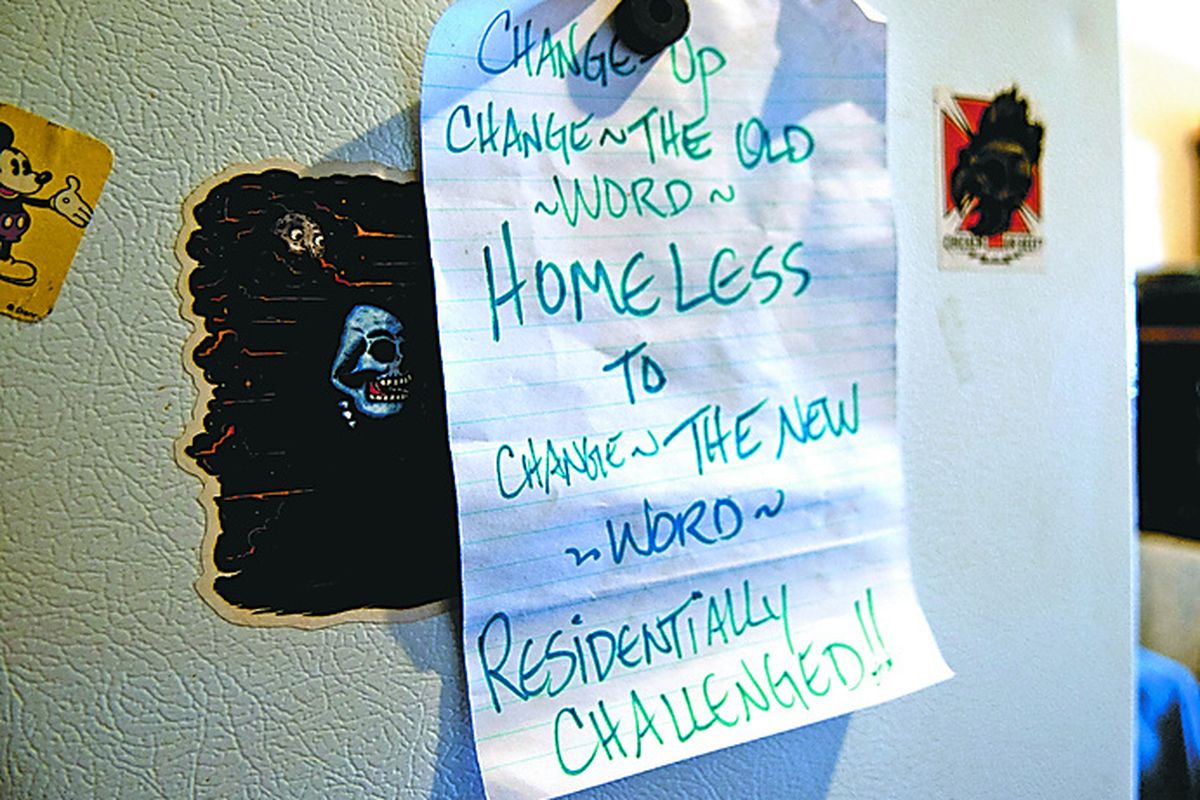Housing First approach puts stable shelter at top of the list
“I was homeless,” said Kayletta Thomas, looking out her window at the Collins Apartments in Spokane on March 30. The Housing First project is funded by the city to help the chronically homeless. It has 21 units, with a program manager on-site and other staffers to help its tenants get housing assistance, addiction treatment and mental health care. (Kathy Plonka)Buy a print of this photo
Douglas Glen first snorted meth as an ironworker in Las Vegas, trying to keep up with an all-day everyday schedule.
He knew a guy named Speed, and Speed had a suggestion. He tapped out a line of white powder.
“ ‘Do that,’ he said, ‘and you’ll have plenty of energy,’ ” Glen said. “It took me right down to the ground.”
Glen’s meth addiction stayed with him as he lost everything, eventually finding his way to Spokane, where he lived on the streets and in the shelters.
“I still … dabble in it,” he said. “I’m my own worst enemy. I know I shouldn’t be doing it.”
Here’s the thing about that dabbling: Glen’s drug use was both a cause of his homelessness and a barrier to getting help. Housing programs run by governments and nonprofits have often emphasized housing “readiness” or “worthiness,” including abstinence requirements. Homeless people living chaotic lives of drug addiction and mental illness often simply didn’t qualify, or even try to.
But there has been a sea change in this thinking that has helped Glen and people like him find permanent, stable housing. Instead of emphasizing readiness and worthiness first, officials strive to put people into safe, stable, permanent housing as fast as possible, then tackle their problems. This “Housing First” philosophy has taken root across the country, from liberal Seattle to conservative Utah, and it’s now the operating principle behind most government funding for homeless programs.
Spokane is about to undergo a major expansion of Housing First projects.
Catholic Charities first put the model into practice here with its 50-unit Father Bach Haven project two years ago. The nonprofit will break ground on another 50-unit housing project this spring – right next door to a similar project by Volunteers of America. And those are just the first of several projects planned in the next few years – “one a year each year until 2019,” said Rob McCann, executive director of Catholic Charities. “Our goal is by 2019 we will have a unit for every chronically homeless person in Spokane.”
The city of Spokane also has revamped its housing programs, moving away from a one-size-fits-all model and toward one that includes Housing First and other efforts more tailored to individual needs. Last fall it opened a Housing First project at the Collins Apartments, offering 21 units, with a program manager on-site and other staffers to help tenants get housing assistance, addiction treatment, mental health care – whatever they need, down to dishes or a mattress. Catholic Charities runs that program for the city, with an annual budget of about $280,000.
Glen has been in the Collins since it opened. His small apartment on the third floor has a couch, a mattress on the floor, and two large windows that were open to a sunny, breezy day recently. He’s trying to stop using meth, but he doesn’t pretend that he’s succeeded. Under the old model, this might have disqualified him for housing.
At the Collins, though, Glen spoke frankly about his drug use – how he yearns for that first hit, that first high, and how he crashes and feels lousy afterward – in front of officials and caseworkers. They want him to quit, and they’ll help him try to quit, but they won’t put him back on the streets if he doesn’t. If anything, social workers say, keeping the homeless safe and sheltered reduces harm, puts them in a supportive environment and offers more immediate help for them when they struggle.
“Try to get sober on the streets?” said Reese Holford, program manager at the Collins. “Good luck.”
‘A massive shift’
Housing First projects are showing great promise at driving down chronic homelessness. In Utah, it has plummeted by 72 percent since a Housing First strategy was adopted 10 years ago, state officials say. Supporters say the approach is effective and humane, but it also appeals to government and business leaders eager to move the most visible and troubled homeless people off the streets.
The projects can be expensive – the new Catholic Charities and Volunteers of America projects will cost $10 million each just for bricks and mortar. But early efforts with Housing First suggest that they save money. The chronically homeless create expensive problems. They wind up in emergency rooms with great frequency. They draw police and fire resources at a disproportionate clip. They take up expensive jail beds – sometimes just in an effort to secure food and shelter.
McCann said a chronically homeless person in Spokane – someone constantly using public and social services – can cost $200,000 or $300,000 a year.
“For that kind of money, I can build that guy a house and have somebody sit on his couch 24/7,” McCann said.
Researchers examined the public costs and benefits of a Housing First program in Seattle from 2005 to 2007. In a paper published in the Journal of the American Medical Association, they concluded that spending just six months in a Housing First program cut the overall spending on the typical homeless individual by 53 percent – comparing the cost of the program to the typical costs of hospital care, jail, police and fire calls, and other services. The longer they stayed in the program, the greater the savings.
For most of the past several decades, the model for helping the homeless was built on emergency shelters and transitional housing. Shelters offer temporary crisis help, not stable, long-term residence. Transitional housing offered programs, often up to two years, based on the idea of increasing responsibilities that helped the homeless move toward “readiness.” Often, there were rules against drinking, smoking, pet ownership and other activities.
The transitional housing model, however, often didn’t serve two of the largest groups of homeless people: those who needed only a short-term solution until they get back on their feet and the chronically homeless – those with the most stubborn problems, generally severe untreated addictions and mental illnesses.
Since 2012, Spokane’s city-run housing program has focused much more on different types of programs. One of those is “Rapid Rehousing,” in which people get fast, temporary help. This is often for families who need short-term assistance to get back on their feet. On the other end of the scale are the chronically homeless, under Housing First programs.
The homeless go through a front-end assessment process that directs them into the right program – a way to get people quickly connected to the right services.
“The city, in the last few years, has undergone a massive shift,” said Jonathan Mallahan, director of Neighborhood Services and Code Enforcement for the city of Spokane.
If you come to the city in need, he said, the first response is: “We’re going to put you into a home. We’re going to stabilize you and make you safe.”
Part of this evaluation is identifying the people on the streets with the greatest needs – the ones with the worst problems and at the most risk – and getting them sheltered.
Some resistance in social service field
The result of these changes, Mallahan said, is that the city has been able to help more people without spending more money. The city oversaw about $14 million in housing assistance in 2014 – money that comes from federal programs and local and state taxes. Programs range from loans for low-income families to homeless services. From 2012 to 2014, the number of homeless families with children who were being helped nearly doubled, from 631 to 1,175.
Sheila Morley, the manager of the Housing First grant for the city, remembers when some of these new approaches were first being discussed several years ago, and how much resistance there was from people steeped in the transitional housing model.
“People thought I had lost my mind,” she said.
A New York University study in 2013 concluded that there was resistance to Housing First among many service providers in the “massive homeless ‘industry’ ” who were committed to abstinence and resistant to tenant freedom and choice, since “bad choices are considered responsible for the clients’ predicament in the first place.”
But the study concluded that research supporting the “housing worthiness” model is “virtually nonexistent,” while evidence-based support for Housing First is growing. The researchers cite 2011 statistics that dropout rates in the old model can be as high as 54 percent, compared with 11 percent in Housing First.
‘I love it here’
Brian Schaeffer is Spokane’s assistant fire chief. His department is often the one called – at great expense – to deal with those who get drunk and fall down and hurt themselves, or go through a public mental health crisis.
He began to wonder why. Why did this man wind up back in the ER three times for one infection? Why did that woman stop taking her meds? Why did this man miss his appointment with a social worker? Why did the same crises keep popping up with the same people?
“It seemed like everything came back to housing,” he said.
There is a tendency to think about homelessness as the end product of problems, which it undoubtedly is. But Schaeffer and others say that housing, in and of itself, starts to make it easier to address those problems. If someone has stable housing, there’s a place to find them. A place to get them food or meds. A place to rest and recover from illness. A place for a social worker to come for appointments.
“Homelessness is a disease,” McCann said. “It’s an illness. The best prescription for that disease is housing. … What we’re seeing now is homelessness as a result of major untreated mental illness and major untreated substance abuse, and often the two in combination.”
Father Bach Haven, the city’s first top-to-bottom Housing First building, seems in many ways like any new apartment building: Key-card security. Post office boxes in the lobby. Common spaces, a laundry room and a courtyard out back.
But there are also elements that are utterly unique: An on-site program manager. A shelter serving meals next door. Someone who will help tenants remember a doctor’s appointment or find counseling or apply for disability benefits.
Connie Birdtail, the social services coordinator, works on-site to connect residents to the social services or medical care they need, helping them negotiate the complexities of a bureaucratic system that can be difficult even for experts to understand, let alone people who move into the building with nothing more than a backpack to their name.
Though there is not a sobriety requirement, there are rules. Drug use is prohibited on the site, though people aren’t kicked out if they’re high. Residents are free to make their own choices in many ways, but if they are disruptive or violent they can be booted. That hasn’t happened much so far. Since the place opened, McCann said, just four people have landed back in jail or out on the streets.
“To have only four out of all those people who went back to jail or back to a shelter – those are crazy great statistics,” McCann said.
Catholic Charities and Volunteers of America will use a federal tax-credit program to build their new projects on East Second Avenue between Cowley and Spokane streets. Each will cost about $10 million and add 50 apartments for the homeless. Once they’re built, tenants will pay rent with housing assistance vouchers to fund services in the buildings.
Theresia Beckett has been in Father Bach Haven since it opened two years ago. She had been released from prison – something she refers to only vaguely as “going down the wrong path.” She was living in a “dump” of a motel on East Sprague Avenue, broke and down to her last paid day, when she found out she qualified.
Now, she says she never wants to leave. Her small apartment has a twin bed covered in a quilt from an aunt, a small bookshelf and chest of drawers, a tidy kitchen and a large window overlooking the train tracks. At the foot of her bed is a stool with a needlepoint saying: “Home is where the Heart is.”
“I love it here,” said Beckett, 60. “No matter what’s going on out in the world or even out in the hallway, once I come in here and close the door, this is mine. … Everything in here is a little piece of my life.”
Like a family
Back in Douglas Glen’s apartment at the Collins, he’s talking about how having neighbors has helped him fight occasional depression. Just walking down the hall to the shared bathroom can lift his mood, he says.
“Just interacting with people from time to time will take that low feeling away,” he said.
He has great affection for the building’s program manager, Reese Holford. He brings her Reese’s Pieces candies when he can, as a small, personal thank-you.
“It’s kind of like one big family, you know?” he said. “It’s a good place.”
As Glen’s life was falling apart – losing his job and home in Nevada after a career of 20-plus years – he moved to Washington and wound up hitchhiking to Spokane, where he stayed frequently at the House of Charity shelter. Glen had always told himself that he would never “fly a sign” – stand on a corner with a cardboard sign asking for money. But he did. At first, he said, he would stand on corners with a sign reading “Anything Helps” held in front of his face – “because of my pride,” he said.
“I never thought I would get that low. Now I’m going back up again.”




